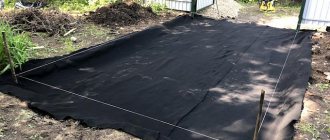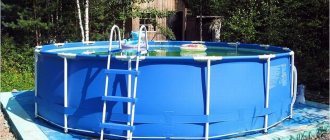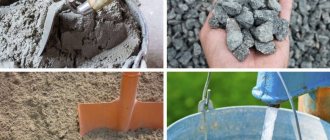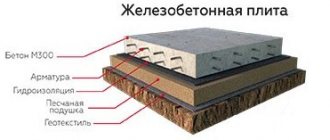To make life at the dacha comfortable, it is necessary to carry out basic communications - water supply and sewerage. In suburban areas there is often no centralized sewerage network, so each house owner solves the problem independently. Periodic use of the home does not require the installation of expensive and complex equipment; it is enough to install a septic tank.
Often in dachas, the function of collecting wastewater is performed by a cesspool. If the house is not equipped with a plumbing system, this option is fully justified, but when installing plumbing fixtures and a large volume of drained water, it is not enough. In this article we will talk about how to make a sewer system in a country house with your own hands in various ways (from concrete rings, barrels, without pumping), and also demonstrate diagrams, drawings, photos and video instructions.
The sewerage system must be built in accordance with the developed project, which includes external and internal piping diagrams.
Sewerage diagram of a country house or dacha The sewerage system
inside the dacha includes in its system the connection points for plumbing fixtures (sinks, shower without a tray, toilet, bathtub), mains and risers; it ends with an outlet pipe located in the area of the foundation.
The external network consists of pipes that drain wastewater from the building and the treatment or storage facility. After preparing the project, you can calculate the size of the pipes, the amount of material for work, and select the type of sewer collector.
Familiarity with the regulatory documents will help you understand how to make a sewer system in your dacha correctly and avoid design mistakes. The diameter of the pipes is selected in accordance with the throughput of the system; a small size will not cope with a significant volume of wastewater, and a large size will require extra money.
Choosing a location for a septic tank
The location of the septic tank is influenced by several factors:
- the terrain of the site, the movement of water is carried out by gravity, so it is important to take into account the slope;
- groundwater depth;
- frost mark in winter;
- location of drinking water supply or water source;
- Soil composition – sandy soil easily allows liquid to pass through, so it can cause groundwater pollution.
Installing a septic tank requires compliance with certain conditions: the distance from the house must be at least 5 meters, the distance from the drinking well is 30 meters, and from green spaces is 3 meters. The place is equipped with the possibility of a sewer truck entering.
Which option should I choose?
Installing a septic tank is considered the optimal and affordable option for implementation on your own. Sewerage for a dacha is an important element of landscaping, but no one wants to spend too much money on it. In terms of labor costs, construction is approximately equal to the creation of a cesspool, and the effect and savings are much higher. In addition, it is not necessary to install a powerful treatment system; a small structure that meets the needs of one family is quite sufficient. To create, you will need the most ordinary tools; you can use improvised or used materials. The main task is to correctly understand the principle of operation and do everything carefully, taking into account possible difficulties and nuances.
Work on the installation of internal sewerage
Installation of sewerage inside the building
Having a diagram of the location of all points of the system, and having purchased the necessary material, you can begin its installation. The central riser is installed first. Its diameter is chosen to be about 110 mm, and to remove gases, the upper part protrudes above the roof level or is led into the attic. Two types of pipes are used:
- PVC - the material is chemically resistant, is not subject to corrosion and overgrowing, the smooth inner surface allows drainage to pass through unhindered, installation is carried out using the socket method. PVC prices are quite affordable.
- Cast iron is reliable and durable, but has a large mass and is difficult to install. The cost of such pipes is significantly higher than plastic ones.
- Ceramic - have excellent characteristics, but are expensive.
Sewage outlet 45 degrees
After installing the main riser, located 4 meters from the windows, horizontal pipelines are laid. The ability to monitor the condition of pipes and perform cleaning is provided by inspection hatches, which are located above the toilet and at the lowest point of the system. When installing pipes, avoid turning at a 90-degree angle, which impedes the movement of drains.
Each plumbing fixture must have a siphon with a water seal that prevents the penetration of unpleasant odors into the room. The pipe from the toilet is connected directly, with a pipe of at least 100 mm in diameter.
If a 90-degree rotation device is needed, it can be implemented using two 45-degree corner elements.
To connect the sink and bathtub, pipes with a diameter of 50 mm are sufficient. The lines should be positioned at an angle that allows for water movement. The installation of a sewer system in a dacha involves preliminary preparation of a hole in the foundation for the drainage of the sewer pipe to the outside. A check valve must be installed at the outlet to prevent wastewater from flowing back.
Primitive varieties
The traditional form of waste disposal remains a cesspool. The design is simple to implement, but has a number of significant disadvantages.
Lack of sealing creates a risk of bacteria living in the drains getting into the drinking water. You also need to take into account the specific smell and periodic pumping of the contents.
An improved version of the cesspool is a storage tank. Due to the tightness of the structure, the spread of bacteria and the appearance of odor are eliminated.
Disadvantages remain the need for pumping and significant installation costs.
General rules for SNiP
Determining the slope level of a sewer pipe
- During installation, pipes made of the same material are used.
- The pipeline must be sealed.
- The connection between the main line and the riser is made with an oblique cross or tee.
- The slope of a pipe with a diameter of 110 mm is 20 mm, and a pipe size of 50 mm is 30 mm per linear meter.
- For country houses, a non-pressure sewer system is used; the drainage flows by gravity.
- A hidden option for installing pipes is allowed, and the connection to the main riser must be open.
Stage 1. Project
First, a project is drawn up. The drawing can be made on simple graph paper, but it is better to use a special utility - it’s faster and more convenient. The project indicates the location of plumbing equipment, pipelines and treatment facilities.
Note! Often, for a country sewer system, one treatment device and one outlet pipe are sufficient.
The possibility of connecting other buildings on the site to the system, for example, a bathhouse, is provided in advance. When calculating the size of the sewer network, the number of residents is first taken into account. It is generally accepted that the average person generates approximately 200 liters of wastewater per day.
In addition, climatic features are taken into account. If we are talking about the northern regions of the country, then the outlet pipe is laid below the soil freezing line or insulated. Otherwise, there is a risk of the system freezing in winter.
Septic tank installation
A pit has been dug for a cesspool.
If it is not possible to connect the internal sewage system of the dacha to the central one, a septic tank is installed. This device is designed to collect and purify wastewater. Septic tanks differ in design, material and cleaning method. Before installing sewerage in your dacha, you need to decide on the choice of wastewater receiver. To construct septic tanks, the following are used: plastic or metal containers, brickwork, reinforced concrete structures. Treatment of contaminated water is carried out through soil filtration, biological treatment or wastewater is accumulated and pumped out by a sewer machine.
The easiest way is to install a sealed container in which wastewater accumulates; after filling, it is pumped out using special equipment. The disadvantage of this method is the significant costs of regularly ordering the services of vacuum cleaners.
A more complex device has a septic tank that can partially purify wastewater. There are several options for such a device on sale, but their price is quite high. With a little knowledge and a desire to save money, you can make a septic tank yourself.
Where does the construction of a sewer system begin?
First of all, you need to choose one of 3 types of sewerage:
- Cesspool.
- Storage containers.
- Septic tanks.
cesspool
This type is an outdated form of sewage collection. Today it is considered not only ineffective, but also dangerous to humans and the environment. It is not for nothing that specialized SNiPs state that cesspools can only be used in those houses that emit no more than 1 cubic meter of sewage and sewage. Therefore, this type of sewage system is extremely rare today.
Storage containers
Storage tanks are a common method of arranging sewage systems in suburban areas. They can be of any shape, any type of installation (vertical or horizontal) and are made of various materials.
Reinforced concrete rings have become the most popular among country developers. Installing a sewer system in a dacha with their help is quite simple. The only inconvenience is the need to use special equipment. The rings are quite heavy, so they cannot be handled manually.
There are other options for storage tanks. For example, metal, plastic, as well as wells made of bricks or blocks. So each developer can choose the appropriate option for himself.
The only condition that requires strict fulfillment is the complete tightness of the container. Not a single crack, not a single crack - absolute sealing. In this way, the soil is protected from contamination by human waste.
But this option has a drawback - such a container will have to be cleaned as it fills. There are several cleaning methods:
- Sewage machine. This is a fast and effective option, but very expensive.
- Bleeding pump. This is also a good method, but the wastewater will have to be poured into a separate container and transported outside the countryside to a public disposal site.
- Manual. The entire tool is a rope and a bucket. The method is unpleasant, difficult and dirty. I don't even want to talk about him.
Septic tanks
Installation of a septic tank at the dacha
But a septic tank is perhaps the best option today. It is not just a storage tank, but a system for sequential wastewater treatment.
Its structure is not as complicated as it might seem at first glance. The principle of operation is important here, which is divided into two main stages - pre-cleaning and filtration.
The first stage takes place in a sealed container, where the wastewater is separated into heavy and light. The heavy ones sink to the bottom, and the light ones with water enter the filtration tank or filtration fields.
Today, septic tanks of different shapes, sizes and materials are used, but the principle of their operation is the same. Most often they are made from reinforced concrete rings or ready-made plastic models are used. Sometimes they choose options built from bricks or blocks.
Reinforced concrete septic tanks consist of 2 or more wells, where wastewater flows sequentially. The first well plays the role of a storage tank, and the second - a filtering tank. Through its bottom, purified water enters the soil, and, having passed through all its layers, enters the groundwater
Please note that the more storage wells, the cleaner the output water
Ready-made plastic containers are more effective in this regard. Their internal space is divided into several compartments, from which waste flows in a sequential order. And the more compartments, the cleaner the water.
Two-chamber septic tank
Concrete septic tank design
The most convenient is to install a collector of two chambers connected by an overflow pipe. Let's find out how to arrange it yourself.
- Work begins with digging a pit in a place chosen taking into account all sanitary requirements. The volume of the structure depends on the number of people living in the country house. You can dig a pit manually or using an excavator.
- A sand cushion up to 15 cm high is formed at the bottom of the pit. The depth of the pit is 3 meters.
- It is necessary to install formwork made of boards or chipboard. The design must be reliable. Next, a reinforcing belt is formed from metal rods tied with steel wire.
- It is necessary to make two holes in the formwork and insert pipe cuttings. These will be places for the entrance of the sewer main and the overflow pipe between the sections.
- The formwork is filled with concrete, which is distributed throughout the entire volume using a vibrating tool. The design of the septic tank must be monolithic, so it is advisable to fill the entire formwork at one time.
- In the first compartment, the bottom is filled with concrete, a sealed section is formed, which will serve as a sump. Here the wastewater will be separated into large solid fractions that sink to the bottom, and clarified water that flows into the adjacent section. For better decomposition of solid residues, aerobic bacteria can be purchased.
- The second compartment is made without a bottom; it can be made not only from monolithic walls, but also using concrete rings with a diameter of 1–1.5 meters, stacked on top of each other. The bottom of the well is covered with a thick layer of sedimentary rock (crushed stone, pebbles, gravel) to filter the wastewater.
- An overflow pipe is laid between the two sections. It is installed at an angle of 30 mm per linear meter. The height of the pipe is located in the upper third of the wells. The number of sections is not necessarily limited to two; a four-section septic tank can be made, which provides better cleaning.
- The ceiling of the septic tank is made independently, using formwork and concrete, or ready-made reinforced concrete slabs are used. Be sure to install a hatch that allows you to control the filling of sections and the hood. The pit is filled with sand and selected soil. The sump tank of such a system will be cleaned every 2–3 years.
Due to the ease of installation, many summer residents prefer to make a septic tank from concrete rings.
Construction of a two-chamber septic tank made of concrete rings
If the soil on the site is clayey or the groundwater is located very close to the surface, it will not be possible to install a septic tank of this design. You can settle on a sealed container of sufficient volume, securely installed and secured to a concrete slab in the pit.
Installation of an autonomous septic tank Topas
Alternative. Dry toilets
Dry toilets
If there is no central water supply at your dacha, you can install a dry closet (preferably a peat one). Such devices are compact and consist of two containers:
- the top one, intended for storing dry peat, also has a seat installed on it;
- lower, in which excrement is composted.
The dry closet needs regular cleaning, but the peat waste removed from the lower container can be used as fertilizer in the future.
Peat toilet
Note! In addition to the peat mixture, special bioactivators are added to the structure to speed up the composting process. A 30 g package of activator costs approximately 350 rubles.
Despite the plastic body, the dry closet is quite durable and can withstand weight up to 250 kg. It is worth noting that there are also electric models of such toilets - they are no less effective than peat ones, but they also cost accordingly. In addition, they need to be connected to an uninterruptible power supply.
Prices for popular dry closet models and accessories
Dry toilets and accessories
Laying the external main
The pipe is laid with a certain slope.
From the point where the sewer pipe exits the house to the septic tank, it is necessary to lay a pipeline. The main must lie at a slope that ensures the drainage of contaminated water. The larger the diameter of the pipes you use, the smaller the angle of inclination required for their operation, on average it is 2 degrees. The depth of the trench for laying pipes must be greater than the amount of winter freezing of the soil. If the depth of the trench is small, provide thermal insulation of the line.
The average depth for laying a sewer system is 1 meter; in warm regions it is enough to go down to 70 cm, and in cold regions you will need to dig a pit up to 1.5 meters. The bottom of the dug hole is covered with a dense cushion of compacted sand. This procedure will protect the pipes from soil displacement.
A pit for a septic tank near the fence.
The best option would be to lay a direct pipeline to the collector. If it is necessary to make a turn, this place will be equipped with an inspection well. For the main line, you can use plastic and cast iron pipes with a diameter of 110 mm; their connection must be airtight. After installation, the pipeline is covered with sand and then with soil.
Standards for the location of treatment facilities on the site
There is a lot of confusion in this area. There are many conflicting standards with different distances, and these standards may differ in different regions, so you need to find out exactly from the local plumbing department. The most common standards can be grouped:
- From the house: to the septic tank - at least 5 m;
- filter device (absorption well, sand and gravel filter, filter trench) - at least 8 m;
- to the filtration field - 15 m;
- to the aeration unit - at least 15 m;
- at least 15 meters if the septic tank is located against the flow of groundwater;
One more thing. If there is a slope on the site, then the well or borehole should be located above all treatment facilities. To maintain all these distances, you will have to spend a long time working on the site plan.
If everything cannot be observed at once, special attention is paid to the distance to the neighbor’s house and well (well), since a violation is fraught with a complaint, subsequent inspections and fines.
Septic tank without pumping
The design, which does not require regular pumping of wastewater, consists of several tanks operating simultaneously. These can be two/three-chamber septic tanks. The first tank is used as a sump. It is the largest in volume. In two-chamber septic tanks, the septic tank occupies ¾ of the structure, and in three-chamber septic tanks ½. Here, preliminary wastewater treatment takes place: heavy fractions settle, and light fractions are poured into the next compartment as the first one is filled. In the last part of the septic tank, the final wastewater treatment takes place. The water is then directed to the filtration fields/drainage well.
The first 2 compartments must be sealed. The last chamber has holes in the walls/bottom. In this way, purified water seeps into the ground, which helps avoid systematic pumping of waste without causing irreparable damage to the soil.
It is worth considering that in addition to organic matter, wastewater also contains insoluble impurities. In view of this, such a structure will also have to be pumped out periodically to get rid of the sediment accumulating in the sump. This can be done with a fecal/drainage pump. The frequency of septic tank maintenance depends entirely on the size/volume/composition of wastewater.
Sizing
To independently construct such a septic tank, you need to correctly calculate its volume. It depends on the water consumption of your household. The water consumption rate per person is 200 liters per day. So, multiplying this amount by the number of household members, you will get the daily water consumption in the house. Add another 20% to the resulting figure.
18 m3. In this case, you need a septic tank with a depth and length of 3 m, and a width of 2 m. By multiplying all sides, you get 18 m3. The minimum distance from the bottom of the septic tank to the drain pipe is 0.8 m.
Treatment systems
The advantage of the treatment system is that the sludge is processed by anaerobic bacteria, as a result of which it settles to the bottom in a much smaller volume. Gradually this sediment becomes denser and rises. When the sludge reaches the overflow level, the septic tank must be cleaned immediately. You should resort to cleaning a septic tank quite rarely. This is due to the fact that the volume of sludge in 6 months will be from 60 to 90 liters.
Volatile septic tanks have built-in pumping units. Their non-volatile analogues should be cleaned manually or using sewer equipment.
However, not so long ago, biological products with special enzymes appeared that convert sludge into acid, and then into methane and carbon dioxide. To remove these gases, you just need to install ventilation in the septic tank. Thus, your septic tank will become an absolutely waste-free, safe and energy-independent treatment facility.
Bacteria need to be “fed” with oxygen to make their work more efficient. You can buy containers for a septic tank or make your own.
Installation of a finished septic tank
Before installing the finished septic tank structure, it is necessary to determine a suitable location for this. The minimum distance between the septic tank and the house is 5 m. The sewer pipes leaving the house must be directed directly to the septic tank. It is better to avoid turning the pipeline, because it is in such places that blockages form.
The septic tank should not be installed near trees, as their roots can damage the integrity of the body. The depth of the septic tank and sewer pipes directly depends on the level of soil freezing.
Digging a pit for a septic tank
Permits
To begin with, it is worth saying a few words about the legal issues associated with the construction of a cesspool, septic tank, and other local treatment facilities on the site. The fact is that you cannot create such objects without regard to anything.
In order not to cause problems for yourself, and the autonomous sewer system has been legalized, before starting work, it is necessary to obtain a SES permit for construction. This is due to the fact that any waste entering sewer containers is almost always a favorable environment for the development of a large number of harmful microorganisms. Therefore, sanitary and epidemiological supervision monitors the construction and operation of such structures in order to protect groundwater from biological or chemical contamination that can lead to the spread of various diseases.
In order to obtain permission to build a local sewer system, you will have to collect a package of documents. The list of necessities includes the following:
- Documents confirming ownership of the site and the main building located on it.
- A technical passport with a site plan showing all buildings without exception.
- A copy of the plan on which it is necessary to determine the probable location of the drainage pit or septic tank.
- Design of a septic tank or pit. They will help you develop it in the design organization.
- Project (plan) of a residential building with the location of the bathroom in it.
Example of topographic survey of a site
- Topographic survey of the site, which is carried out by specialists from geodetic organizations. The survey plan displays not only all the buildings and boundaries of the site, its topography, hydrological resources, the presence of vegetation, soil type, and other necessary data.
- Agreement with organizations involved in the removal of various household waste.
The collected documents and application are submitted to the regional SES or to the organization carrying out environmental protection activities. You will have to wait about a month for a building permit. The organization issuing the permit has the right to monitor the correct operation of the local sewage system, timely cleaning, and compliance with environmental standards.
Sewage system made of concrete rings
If you are not satisfied with a ready-made plastic autonomous system for wastewater treatment, due to its size or cost, then you can make a septic tank from several compartments yourself. An excellent inexpensive material for realizing your plans is concrete rings. You can do all the work yourself.
Advantages and disadvantages of the system
Among the advantages of a septic tank made of reinforced concrete rings, we note the following:
- Affordable price.
- Unpretentiousness during operation.
- Possibility of performing work without the help of specialists.
The following disadvantages deserve attention:
- The presence of an unpleasant odor. It is impossible to make the structure completely airtight, and therefore the formation of an unpleasant odor near the septic tank cannot be avoided.
- The need to clean the chambers of solid waste using sewage disposal equipment.
You can reduce the frequency of the need to pump out the septic tank if you use bioactivators. They reduce the amount of solid fractions by accelerating the process of their decomposition.
If the installation of the rings is carried out incorrectly, the septic tank will not be airtight, which will increase the risk of untreated wastewater penetrating into the ground. But, with proper installation, the septic tank will be sealed, so this disadvantage of the system is rightly called conditional.
Scheme and calculations
The design of a septic tank, as a rule, includes 1–2 chambers designed for settling and purifying wastewater and a filtration field/filter well.
If there are few people living in your house and a minimum of plumbing fixtures are connected to the sewer system, then you can easily get by with a septic tank consisting of one septic tank and a filter well. And vice versa, if you have a lot of household members and many devices are connected to the sewer system, then it is better to make a septic tank from two chambers and a filtration well.
Rings for a septic tank
How to calculate the required volume for a septic tank has already been described above. According to building codes, the septic tank chamber must accommodate a three-day volume of wastewater. The volume of the reinforced concrete ring is 0.62 m3, which means that to build a septic tank for 5 people you will need a septic tank of five rings. Where did this amount come from? For 5 people you need a septic tank with a volume of 3 m3. This figure must be divided by the ring volume equal to 0.62 m3. You will get a value of 4.83. It needs to be rounded up, which means that to install a septic tank in this particular case you will need 5 rings.
Preparatory processes
The pit must be of such a size that it can accommodate septic tank chambers and a filter well. This work, of course, can be done manually, but it takes a long time and is very difficult, so it is more cost-effective to order digging a pit from a company with earth-moving equipment.
The bottom of the pit at the site where the settling chambers are installed must be concreted in order to avoid the possibility of untreated wastewater penetrating into the ground. Before starting concrete work, part of the bottom of the pit should be drained to install settling tanks by laying a sand cushion on it in a layer of 30–50 cm.
If you do not want to concrete the bottom, then you can purchase reinforced concrete rings with a solid bottom. They will need to be installed first in a vertical row.
The place for the filter well also requires preparation of the base. Under it you need to make a cushion of sand, crushed stone and gravel at least 50 cm thick.
Installation of rings
To install the rings, you will have to order the services of lifting equipment. Performing these tasks manually is very difficult. You can, of course, install the rings by digging under the bottom ring. But this method is labor-intensive. And the bottom will have to be filled after installing the last ring, which will entail a number of inconveniences. In view of this, it is better not to save on ordering lifting equipment.
Usually the rings are fastened together with mortar, but for greater structural reliability they can be fastened with metal plates or staples. In this case, your septic tank will not be damaged due to soil movement.
Now it’s time to organize an overflow, and for this you need to connect pipes to the rings. It is better that they work on the principle of a water seal, that is, they need to be installed with a bend.
Infiltrators and drainage tunnels
In small areas, the installation of filtration fields is impossible, and the optimal solution here may be the use of ready-made infiltration or drainage tunnels.
They are installed one or two meters from the septic tank, and one such device with a volume of 300 liters replaces about 36 meters of drainage pipes and 800 kg of crushed stone. Externally, the ecnhjqcndj looks like a large container without a bottom; in some models the walls are perforated, in others they are solid (but then a perforated drainage pipe is built into the design).
Miket78FORUMHOUSE Member
Infiltrators form a cavity located underground into which water flows after the septic tank. The water goes into the ground - the cavity is freed. To ensure the required performance, it is not the number of septic tanks that is important, but the absorbency of the soil.
Individual modules of drainage tunnels can be easily assembled with each other into a structure of the required volume. They are installed in the same way as filtration fields, deepened at least half a meter from the surface of the earth, but covered on all sides and on top with a layer of sand or soil at least 50 cm thick.
Device for cleaning waste from barrels
The system for treating wastewater from barrels, like a similar structure made of reinforced concrete, can be two- or three-chamber. Sewage will flow into it by gravity, so it must be installed below the sewer pipes. The operating principle of this device is similar to the design of reinforced concrete rings.
Barrel selection
To set up an autonomous sewerage system based on the principle of a treatment system, you can use any containers. These could be old metal/plastic barrels. The main thing is that they are airtight.
If you decide to make a septic tank from metal barrels, then they should be pre-treated with an anti-corrosion agent.
Pipe supply
Plastic containers have a number of advantages over their metal counterparts:
- A wide range of plastic containers that can be used to equip a septic tank.
- The barrels are highly resistant to the aggressive effects of wastewater. Therefore, they last longer than their metal counterparts.
- The light weight of the containers simplifies their installation at a permanent location.
- Plastic does not require additional processing, unlike metal.
- The high tightness of the barrels eliminates the possibility of dirty water penetrating into the ground.
Plastic barrels must be securely fastened when installed in the ground, because due to spring floods or winter frosts they can be squeezed out of the ground. In view of this, plastic barrels are secured with cables to a concrete base (it must first be poured or a reinforced concrete slab must be installed). To avoid crushing plastic barrels, backfilling of soil should be done extremely carefully.
For seasonal use, sewerage from metal barrels is also suitable, but for stationary use this is not an option.
Metal barrels
The popularity of metal containers for sewerage installations is associated with their compactness and ease of installation. As a lid, you can use an appropriately sized piece of wood or one provided by the manufacturer. To install a metal septic tank, you need to dig a corresponding pit, which also needs to be concreted - the walls and bottom.
Metal containers do not have a long service life even after they are treated with anti-corrosion compounds. Therefore, installing them as a septic tank may be unprofitable. Buying stainless steel containers is not an option, as these products are very expensive.
Maybe you decide that in this case you can buy barrels with thin walls. However, this is also not the best solution, since during operation such a septic tank can be pushed out. And such barrels have a limited capacity - up to 250 liters, which is not suitable for a large family.
To install a reliable wastewater treatment system, it is better to use factory-made polymer barrels.
Materials and tools
To make a septic tank from 220 liter barrels, you will need the following materials:
- geotextiles – 80 m2;
- sewer pipe Ø110 m, length 5 m;
- crushed stone fraction 1.8–3.5 cm, approximately 9 m3;
- corner for sewerage at an angle of 45 and 90º – 4 pcs.;
- plastic barrel with a volume of 220 l – 2 pcs.;
- coupling, flange – 2 pcs.;
- wooden peg – 10 pcs.;
- Y-shaped sewer tee – 4 pcs.;
- building level;
- drainage perforated pipe in the filter 5 m – 2 pcs.;
- epoxy two-component sealant – 1 pc.;
- glue for PVC – 1 pc.;
- plumbing tape – 1 pc.
Tools you will need:
- Shovel.
- Electric jigsaw.
- Rake.
Features of installation of plastic containers
For a dacha/small country house, if used sparingly, standard plastic barrels are suitable. Installing such a cleaning system is not difficult. If you do not pour black waste into the sewer, the septic tank will be unpretentious in maintenance. If there is a toilet in the house, then the sewer will have to be cleaned regularly by calling a sewer service.
For private homes with permanent residence, barrels will not be enough. For sewerage, it is better to purchase plastic cubes/tanks/tanks. The process of installing them in the ground is no different from installing barrels.
Plastic barrel
The distance of the septic tank from the house should not exceed 15 m. Too much distance will complicate the process of connecting the sewerage system to the house:
- there is a need for a large depth of the pipeline;
- On the way to the septic tank you will need to install an inspection well.
Features of installing metal barrels
A sewerage system made from metal barrels does not require large financial investments or complex installation work. To begin with, as in previous cases, you need to prepare a pit, and then install 2 barrels, each of which has a volume of at least 200 liters. Then pipes are installed to transfer liquid from one barrel to another and transfer to the filtration fields/drainage well.
Each subsequent container must be located below the previous one in level.
The joints must be sealed, and the barrels must be insulated using polystyrene foam. After this, the pit and septic tank are filled up. Since, as mentioned above, metal barrels do not last long, you need to be prepared for the fact that after 3-4 years they will need to be replaced.
After watching the video and completing all the work correctly, all that remains is to check the system and enjoy the benefits of civilization.
We recommend that you read:
- Do-it-yourself septic tank from a Eurocube (diagram).
- How to defrost a sewer pipe using chemicals.
Calculation and optimal depth of the cesspool
Calculation is the primary procedure in the construction of an autonomous sewer system. For a family of 3-4 people, a cesspool with a volume of 1.5 cubic meters will be sufficient. meters.
Regardless of the selected depth, calling a sewage disposal truck to perform cleaning is inevitable. When making calculations, you should take into account the presence in the house of such devices as a dishwasher and washing machine, which significantly increase the rate of filling of the sump. Another factor influencing the final size of the sewer is the design of the pit itself. The presence of an additional absorption pit will allow part of the wastewater to go into the soil, thereby increasing the size of the sump. With a reasonable size, the system is not capable of causing harm to nature.
Usually, the absorption pit, due to the absence of the need to accumulate sewage masses, is made of a small size. It should be remembered that the soil is capable of absorbing a minimal amount of decomposition products and other waste. When significant volumes of waste leak, the soil becomes poisoned and subsequently serves as a source of contamination for the surrounding area and people. It is recommended to place a peat cushion at the bottom of the cesspool, which will prevent fecal matter from being absorbed.
Learn more about the layout and depth of installation of an autonomous sewer system.
Photo
Digging a hole
Laying the outer pipe
Pipe laying
Layout of sewer pipes
Formwork for a concrete septic tank
Concrete septic tank
Concrete cesspool
Cover formwork
Concreting a septic tank
Septic tank from eurocubes
Sewerage from rings
Installing Hole Rings
Installation of several wells
Inspection well
Brick septic tank
Autonomous septic tank for a summer residence
The sewage system at the dacha is decorated
Some tips from the professionals
In order for the sewer system in a private house to work for its intended period, you must first install it correctly. This is 80 percent of success. But even after startup, it is necessary to properly monitor the system.
- Initially, correctly organize and calculate the volume of waste.
- Pump out the cesspool in a timely manner. And not only the liquid fraction, but also the sediment at the bottom of the wells.
- Make sure that no foreign objects get into the pipe that could cause a blockage. For example, small parts of children's toys, rags, etc.
- Conduct a timely external inspection of septic tanks and pits to check their tightness.
Scheme
Scheme of an autonomous wastewater treatment system
Homemade brick septic tank
Operating principle of the drainage field
The principle of sewerage
Scheme of operation of a three-chamber septic tank
Operating principle of the Alta Bio 5 septic tank
Septic tank with two tanks
Septic tank diagram without pumping
Septic tank with filter well
Biological treatment plant diagram
Effluent flow diagram
Filter field design
The principle of water purification
Did the article help you?
With water discharge into the gutter
For this option, it is necessary that a drainage ditch runs next to the site. Then the drainage pipes can be brought into it. However, in front of the ditch you will need to make a pit filled with crushed stone, which will become an additional filter for water.
The use of a drainage ditch is permissible with a high degree of water purification achieved by VOC or AC. And in order to avoid penalties in the event of an inspection, it is better to conduct a chemical examination first.
How to determine the number of cameras
According to GOST, the number of septic tanks is determined by the daily water consumption. If the indicator does not reach one cubic meter, one chamber is enough to clean it. For flow rates up to 10 m3, two containers are needed. If the daily standard exceeds 10 m3, a three-chamber device will be required.
A traditional turnkey sewer system requires two chambers. Single-chamber installations are not capable of providing proper cleaning if several people live in the dacha. And there is often not enough money for three cameras.











